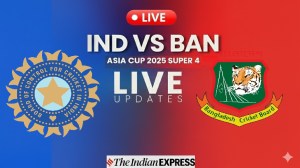Losers in the fast lane
Ms Kapoor, 36, is fasting yet again. Not for any religious reasons, she'll tell anyone who is willing to listen. She has to knock off those ...

Ms Kapoor, 36, is fasting yet again. Not for any religious reasons, she’ll tell anyone who is willing to listen. She has to knock off those few extra kilos and that ugly tyre that is making it impossible for her to get into her favourite pair of jeans.
Ms Kapoor — she prefers Ms to Mrs, so does her husband — is not alone in thinking that fasting will get her back into shape. Even when she eats during the week, she survives on a diet of limbu-pani, salad, fruit and milk. These constitute a complete meal, she has been told by a friend whose sister-in-law’s neighbour hasn’t maintained herself (she’s fat again, to put it crudely), but that’s because "she did not watch what she ate after her diet programme got over," says Ms Kapoor wisely.
Fasting is increasingly becoming a cost-effective way of losing weight. And how. Since water constitutes about two-thirds of the total body weight, loss of weight generally associated with fasting has more to do with the loss of body fluids. At quick weight-loss centres,too, work toward a diet which limits the intake of salt to fruit and vegetables consumed. Although a low-salt diet is healthy and brings down your blood pressure, some amount of sodium is essential to maintain the fluid level. A decrease in the level of salt results in the body losing water.
This can cause a drastic weight loss of up to five kilos in two weeks. After this initial spurt, weight loss becomes more gradual. And when a normal diet, with a regular salt intake is resumed, the body gains back the weight it had lost just as rapidly. About seven to 10 gm of salt is required daily by the human body under normal conditions, though the intake may go up in hot weather or during periods of heightened activity. A deficiency can lead to lethargy, tiredness and dizziness.
Six to eight glasses of water a day need to be taken under normal circumstances. The rest of the water requirement is provided by the food consumed. During fasting, however, since the salt intake is minimal, the body loses more than thenormal amount of water. This makes it essential for the person fasting to take more than the required amount of fluids.
It’s well-known that in the absence of a steady supply of glucose, the body breaks the accumulated fat for energy. Along with the fat, however, it also loses high density lipoproteins (HDL) — the good cholesterol that carries cholesterol back to the liver to be recycled without any deposition in the body tissues. This results in an increase in the low density lipoproteins (LDL) that carry cholesterol to the cells where it gets deposited, narrowing down the arteries and affecting the body flow.
Exercise maintains the HDL levels even as it brings down LDL amounts in the body. Incidentally, the total cholesterol count should be between 150 mg and 175 mg. The TDL count should be three mg or more, and the LDL should be under 130 mg. Any deviation is cause for concern.
Diabetics need to be more careful. Since the brain depends on glucose as an energy source, it draws on the adipose tissuesin the body as an alternate energy source in the absence of it. The fat gets broken into free fatty acids that form ketone bodies in the liver. "An increase in the level of ketone bodies in the blood can cause keto acidosis, a life-threatening condition among diabetics," says S K Wangnoo, senior consultant, Diabetics and Endocrinology, Apollo Hospital. "Initial symptoms are low blood pressure, dehydration and vomiting, which may ultimately lead to collapse."
Says Shikha Khanna, president of a dietician’s body, "It’s best to eat fruit during a fast. And if you don’t want to eat anything for some reason, make sure you drink plenty of water to avoid dehydration." This long-practising dietician feels that absolute fasts are best avoided.
Wangnoo disagrees. "Total fasting for up to 72 hours doesn’t cause problems as a healthy body has enough stores to see it through. Even gastritis problems that occur are a temporary phenomenon," he says. According to him, the real danger lies from the ketone bodies, which canharm brain function.
It’s important to eat right even after a fast. Make sure you eat a light meal, preferably curd and fruit, after a fast. A dull meal suddenly puts too much load on the stomach, causing indigestion, gastric problems and headaches. Says T S Mahant, a consulting cardiologist, "Eating rich food after a period of fasting results in the `dumping syndrome’, where a lot of sugar and water are suddenly drawn into the stomach, resulting in nausea and sickness." That is why most people are asked to break their fast with a glass of limbu-pani.
It’s healthiest not to fast at all. A controlled diet is a more effective way of losing weight, for fasting, that is not eating at all, is as unhealthy as overeating or going on a food binge.
Hard & Fast Rules
Weight a Minute
Photos



- 01
- 02
- 03
- 04
- 05




























